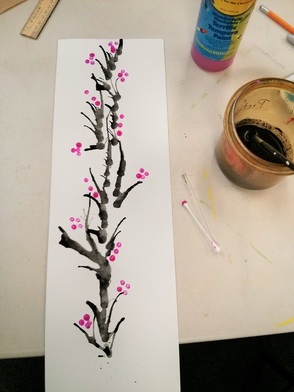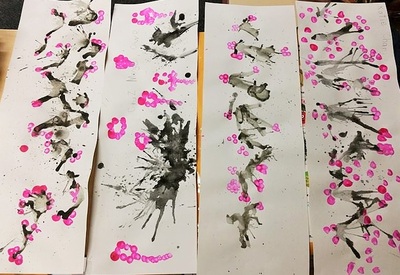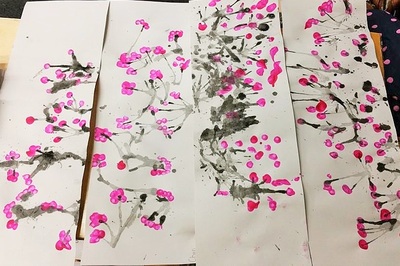Kindergarten
Japanese Cherry Blossom Painting
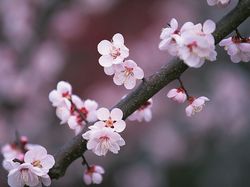
In much of Japan, the flowering cherry trees (which the Japanese call sakura) come into full bloom around the beginning of April. April is the month when the new school year starts for Japanese children; it's also the month when companies start their new business years and when many new graduates start to work. So the cherry blossoms make people think of new beginnings. When they are in bloom, people make special visits to parks and other spots with many cherry trees; often they have picnics under the branches with family and friends.
Japan has more types of cherry trees than any other country, over 200 in all. The blossoms are pickled and used to make a hot drink served on special occasions, and the leaves are pickled and used as the wrapping for sweets.
The sakura start blooming in the south at the end of March and work their way north to Hokkaido in May. This helps people plan their flower-viewing outings. Festivals are also held every year to mark the cherry blossom season in many famous viewing spots.
Japan has more types of cherry trees than any other country, over 200 in all. The blossoms are pickled and used to make a hot drink served on special occasions, and the leaves are pickled and used as the wrapping for sweets.
The sakura start blooming in the south at the end of March and work their way north to Hokkaido in May. This helps people plan their flower-viewing outings. Festivals are also held every year to mark the cherry blossom season in many famous viewing spots.
Above are several examples of the cherry blossom in Japanese art. It is a very popular motif in Japanese painting. The Japanese culture loves nature in art because they are very respectful of the power of nature (think of storms and earthquakes) and also the beauty all around us (good for meditation or quiet thinking). Cherry blossoms are an example of the simple beauty that can be found in nature. Note the interesting lines of the branches and the pop of color of the blossoms.
You can also point out that many of the artworks are long and skinny because they are on scrolls of paper instead of just a sheet of paper. The shape of the art also works well for the shape of the cherry branches.
You can also point out that many of the artworks are long and skinny because they are on scrolls of paper instead of just a sheet of paper. The shape of the art also works well for the shape of the cherry branches.
The Project
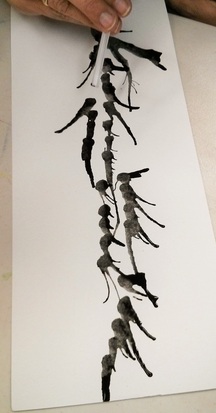
Art Lesson
1. Talk about print and importance of cherry blossoms to Japanese culture.
2. Explain the new and fun way they will be creating Cherry Blossom branches with blowing paint today.
3. Model blowing paint for students: put a drop of paint at bottom of paper with straw, blowing up, adding more dots and continue to blow. Model straw at an angle to get best results.
Pass Out Supplies
-name on back of paper with pencil
-paper goes vertically, good to explain the difference between vertical and horizontal.
-when students have finished blowing black paint for branches to top of paper, hand out Q-tips to make cherry blossoms.
-model how to use Q-tips to make pink dots near each other for a flower.
-tell students to add 5 or more cherry blossom flowers to their branches.
-when done have parent helpers wash out palettes, set aside art to dry.
*please put all art supplies back in Art PREP room
1. Talk about print and importance of cherry blossoms to Japanese culture.
2. Explain the new and fun way they will be creating Cherry Blossom branches with blowing paint today.
3. Model blowing paint for students: put a drop of paint at bottom of paper with straw, blowing up, adding more dots and continue to blow. Model straw at an angle to get best results.
Pass Out Supplies
-name on back of paper with pencil
-paper goes vertically, good to explain the difference between vertical and horizontal.
-when students have finished blowing black paint for branches to top of paper, hand out Q-tips to make cherry blossoms.
-model how to use Q-tips to make pink dots near each other for a flower.
-tell students to add 5 or more cherry blossom flowers to their branches.
-when done have parent helpers wash out palettes, set aside art to dry.
*please put all art supplies back in Art PREP room
Citations:
- Barbara Friedman, Cherry Blossoms 2015. www.flickr.com, https://www.flickr.com/photos/btf5/16724057063/in/photolist-rtRavr-eJWDoF-eJWEc8-FzZQaJ-mCAJJi-n2E1VR-2mBzC-7QaxNS-FETZLu-bCugfG-FfSHzb-6csuo7-eK94hj-7KJyKm-eK91My-GxjHwr-6dp1pB-c1k6PC-n74Uym-7RR4Jz-ER8UdZ-6ctTi3-9wQXRv-zAsRFT-zquD5-bMixbB-FJ5MRa-58EXCZ-qwGXSZ-sjvKyG-bxhv57-9wiGyq-9LQnsB-9xVXui-njFYQH-6d8Ra8-n86Qcp-DwvpKN-7QiXvR-DmghuB-eebDFp-e7Suc6-cdmzs-9yxLfk-FrPjP-bMixhn-aju7U-4Jrdp3-6ctTqY-7Sx73g
- Hiroshinge, Small Bird on a Branch of Kaidozakura. www.wikiart.org, https://www.wikiart.org/en/hiroshige/small-bird-on-a-branch-of-kaidozakura-1848
- Ohara Koson, Bird in Cherry Tree. Photo by Cesar Ojeda, 2014. www.flickr.com, https://www.flickr.com/photos/odisea2008/14150895858/
- Ohara Koson, Songbird on blossom branch. Photo by Rawpixel Ltd, 2018. www.flickr.com, https://www.flickr.com/photos/vintage_illustration/46314476832/
- Katsushika Hokusai, Cherry Blossoms and Warbler 1827. www.wikiart.org, https://www.wikiart.org/en/katsushika-hokusai/cherry-blossoms-and-warbler
- Katsushika Hokusai, Mount Fuji seen through cherry blossom. www.wikiart.org, https://www.wikiart.org/en/katsushika-hokusai/mount-fuji-seen-throught-cherry-blossom
- Hiroshi Yoshida, The Cherry Tree in Kawagoe 1935. www.wikiart.org, https://www.wikiart.org/en/hiroshi-yoshida/the-cherry-tree-in-kawagoe-1935
- Hiroshi Yoshida, Avenue of Cherry Trees 1935. www.wikiart.org, https://www.wikiart.org/en/hiroshi-yoshida/avenue-of-cherry-trees-1935
- Hiroshi Yoshida, Hirosaki Castle 1935. www.wikiart.org, https://www.wikiart.org/en/hiroshi-yoshida/hirosaki-castle-1935
- Hiroshi Yoshida, In a Temple Yard 1935. www.wikiart.org, https://www.wikiart.org/en/hiroshi-yoshida/in-a-temple-yard-1935
- Ohara Koson, Cherry Blossom with Birds. www.wikiart.org, https://www.wikiart.org/en/ohara-koson/cherry-blossom-with-birds
- Ohara Koson, Redstart on Cherry Branch. www.wikiart.org, https://www.wikiart.org/en/ohara-koson/redstart-on-cherry-branch
- Map of Japan, https://web-japan.org/kidsweb/explore/map/
